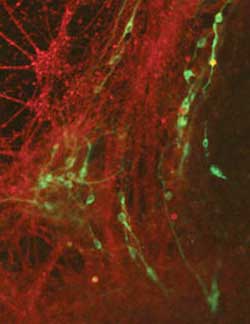An embryonic stem cell model for Parkinson’s disease

Despite the well-characterized cellular basis of Parkinson’s disease — the degeneration of dopamine-production neurons — the molecular mechanisms responsible for the neurodegeneration remain unknown. Part of the challenge is finding a model that can adequately mimic the loss of dopamine cells. In two papers published in PLoS Biology, Asa Abeliovich and colleagues make the case that a model based on mouse embryonic stem cells offers a promising platform for dissecting the disease mechanism of Parkinson’s.
Working with these cells, the researchers created dopamine neurons deficient in DJ-1, a gene mutated in an inherited form of Parkinson’s. They report that DJ-1-deficient cells — and especially DJ-1-deficient dopamine neurons — display heightened sensitivity to oxidative stress, caused by products of oxygen metabolism that react with and damage cellular components like proteins and DNA. In a second paper, they link DJ-1 dysfunction to the aggregation of alpha-synuclein, a hallmark of Parkinson’s neuropathology.
Oxidative stress has long been associated with neuronal cell death and neurodegenerative diseases like Parkinson’s. Proving a causal relationship between oxidative stress and neurodegeneration, however, requires establishing a molecular mechanism. These results support a link between oxidative damage and disease, and provide a tractable model for both studying the molecular mechanisms of neurodegenerative disease and screening potential neuroprotectant drugs. The authors are hoping to extend their work to human embryonic stem cells, but their work is limited by the availability of such cells under the current NIH guidelines.
Media Contact
More Information:
http://www.plos.orgAll latest news from the category: Life Sciences and Chemistry
Articles and reports from the Life Sciences and chemistry area deal with applied and basic research into modern biology, chemistry and human medicine.
Valuable information can be found on a range of life sciences fields including bacteriology, biochemistry, bionics, bioinformatics, biophysics, biotechnology, genetics, geobotany, human biology, marine biology, microbiology, molecular biology, cellular biology, zoology, bioinorganic chemistry, microchemistry and environmental chemistry.
Newest articles

Superradiant atoms could push the boundaries of how precisely time can be measured
Superradiant atoms can help us measure time more precisely than ever. In a new study, researchers from the University of Copenhagen present a new method for measuring the time interval,…

Ion thermoelectric conversion devices for near room temperature
The electrode sheet of the thermoelectric device consists of ionic hydrogel, which is sandwiched between the electrodes to form, and the Prussian blue on the electrode undergoes a redox reaction…

Zap Energy achieves 37-million-degree temperatures in a compact device
New publication reports record electron temperatures for a small-scale, sheared-flow-stabilized Z-pinch fusion device. In the nine decades since humans first produced fusion reactions, only a few fusion technologies have demonstrated…





















